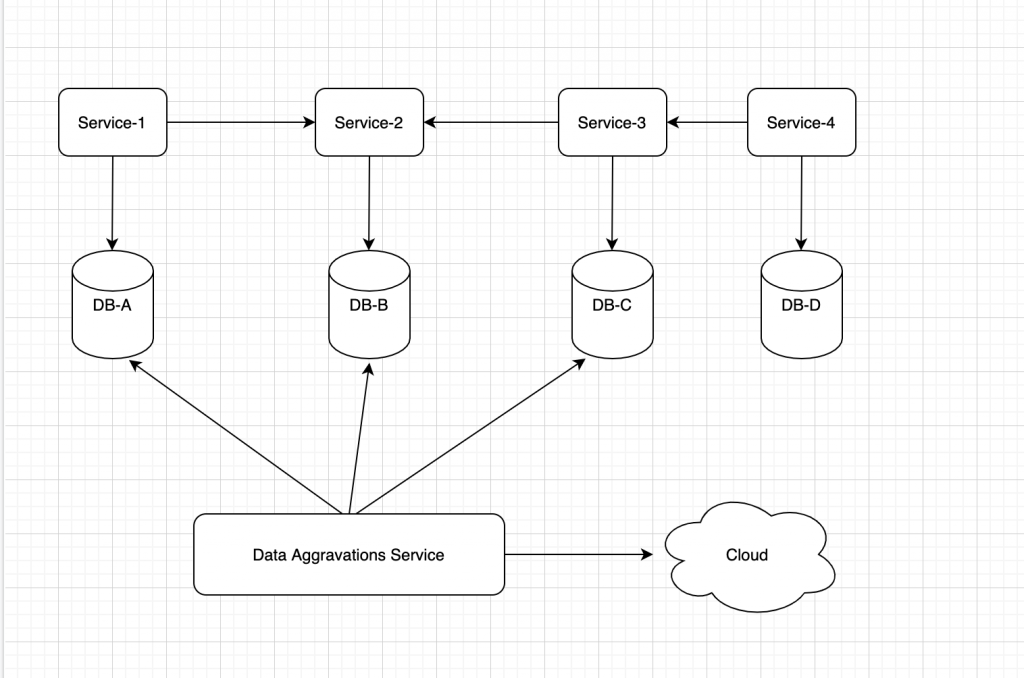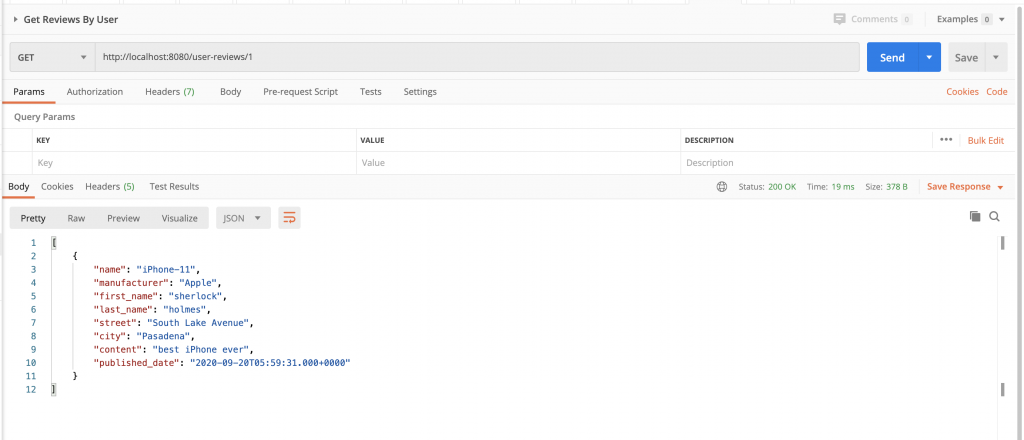In Micro service architecture , we generally have a dedicated database schema for each service (though there are exceptions). Each service is then responsible for managing data from its data base and then taking to or responding to other micro services .
Now since we have different data bases schema the data access layer for each micro service is different . But that doesn’t mean data is not related. We can have entities that are related across schemas.
Consider below diagram , few micro services interacting with each other (service discover not shown for simplicity) . Data Aggregation Service interacts with three different data base schemas and processing it and sending over network or cloud service like SNS or SQS or simply sending it to any third party consumer.

This Data Aggregation service should be able to access data from multiple databases schemas as per requirement but with minimal data base trips. SQL query over multiple data bases schemas is possible with joins but what about data access layer ? We know when using ORM we can easily access related data from different tables when relations are defined in Entity classes or configuration depending on which implementation of JPA you are using . For example lets say for online shopping site we have Users table and Addresses table and they have one to many relation. So using JPA 2 Hibernate implementation i’ss quite simple to define this relation on Entity level and then extract Addresses using User we all know that very well.
Here is scenario, Let’s say we have micro-service-1 which handles users and address operation but another micro-service-2 handles reviews given by User and uses Reviews table .
A Separate micro-service-3 handles Products which can include Type of product , its manufacturer and lot more but for simplicity we will consider this service handles only one table as of now called products
There is requirement of another micro-service say data aggregation service which should fetch data from Users,Products and Reviews tables and push this data to cloud service for analytics .
Lets Start by creating schema , we are just crating micro-service-3 data access layer to understand how JPA can be used to access related data across the schema’s. For simpler explanation just assume micro-service-1 and micro-service-2 are populating their respective tables and our service has read-only access to those tables. We are populating tables with insert statements.
Create 3 schema’s product_service, user_service, review_service and run below sql queries.
-- products service data base tables
CREATE TABLE `product_service`.`products` (
id bigint(20) NOT NULL AUTO_INCREMENT,
name varchar(30) NOT NULL,
manufacturer varchar(30) NOT NULL,
type varchar(30) NOT NULL,
PRIMARY KEY (id)
);
-- user service data base tables
CREATE TABLE `user_service`.`users` (
id bigint(20) NOT NULL AUTO_INCREMENT,
first_name VARCHAR(30) NOT NULL,
last_name VARCHAR(30) NOT NULL,
PRIMARY KEY (id)
);
CREATE TABLE `user_service`.`addresses` (
id bigint(20) NOT NULL AUTO_INCREMENT,
user_id bigint(20),
street varchar(30) NOT NULL,
city varchar(30) NOT NULL,
state varchar(30) NOT NULL,
PRIMARY KEY (id),
FOREIGN KEY (user_id) REFERENCES users (id) ON DELETE CASCADE
);
-- reviews service data base tables
CREATE TABLE `review_service`.`reviews` (
id bigint(20) NOT NULL AUTO_INCREMENT,
user_id bigint(20),
content varchar(255),
published_date timestamp DEFAULT CURRENT_TIMESTAMP,
PRIMARY KEY (id)
);
-- Insert Data
INSERT INTO `product_service`.`products` (name,manufacturer, type)
values ('iPhone-11', 'Apple','mobile');
INSERT INTO `user_service`.`users` (first_name,last_name)
values ('sherlock', 'holmes');
INSERT INTO `user_service`.`addresses` (user_id,street,city,state)
values (1,'South Lake Avenue', 'Pasadena','CA');
INSERT INTO `review_service`.`reviews` (user_id,product_id,content)
values (1,1,'best iPhone ever');
-- Check All Tabled
select * from `product_service`.`products`;
select * from `user_service`.`users`;
select * from `user_service`.`addresses`;
select * from `review_service`.`reviews`;
--- Query to Fetch All Data for User including reviews
select product.name , product.manufacturer, user.first_name , user.last_name,
address.street, address.city, review.content, review.published_date
from `product_service`.`products` `product`
INNER JOIN `review_service`.`reviews` `review` ON `review`.`product_id`=`product`.`id`
INNER JOIN `user_service`.`users` user ON `user`.`id` = `review`.`user_id`
INNER JOIN `user_service`.`addresses` `address` ON `address`.`user_id`=`user`.`id`
where user.id = 1;
product_service schema has Products table that has details of each product. user_service schema has users and addresses and review_service has reviews tables containing reviews of the .
The last query in above section is our requirement. We need to fetch data from multiple schema with given userId and get result from all the tables mentioned below.
Since these schemas are different there is no direct JPA relation between them and that of the result we want instead we need to defined it . But first lets do some basics stuff.
We need pojo’s for the Tables, we also need EntityManager , TransactionManager for each schema and finally we need Repository classes .
All of this code is present at https://github.com/tejasgrd/jpa-multi-schema-access .
We will take example of each here for understanding rest of the code is on similar lines.
Users class with use of Lombok and javax.persistence annotations
@Entity
@Data
@AllArgsConstructor
@NoArgsConstructor
@Table(name = "users",schema = "users")
public class Users {
@Id
@Column(name = "id", nullable = false)
private long id;
@Column(name = "first_name")
private String firstName;
@Column(name = "last_name")
private String lastName;
@OneToMany(mappedBy = "user")
private Set<Addresses> addresses;
}
User repository interface
public interface UsersRepository extends JpaRepository<Users, Long> {
}
Users Database config
@Configuration
@EnableJpaRepositories(
basePackages = {"dev.tejasgarde.jpa.respository.users"},
entityManagerFactoryRef = "usersEntityManager",
transactionManagerRef = "usersTransactionManager")
public class UsersDBConfig extends BaseConfig{
@Bean
public JpaProperties usersJpaProperties() {
return getJpaProperties();
}
@Bean
@ConfigurationProperties("datasources.users")
public DataSourceProperties usersDataSourceProperties() {
return new DataSourceProperties();
}
@Bean
public LocalContainerEntityManagerFactoryBean usersEntityManager(
final JpaProperties usersJpaProperties) {
EntityManagerFactoryBuilder builder = createEntityManagerFactory(usersJpaProperties);
return builder.dataSource(usersDataSource()).packages("dev.tejasgarde.jpa.domain.users")
.persistenceUnit("usersDataSource").build();
}
@Bean
@ConfigurationProperties(prefix = "datasources.users.configurations")
public DataSource usersDataSource() {
DataSource dataSource = usersDataSourceProperties()
.initializeDataSourceBuilder()
.type(BasicDataSource.class).build();
return dataSource;
}
@Bean
public JpaTransactionManager usersTransactionManager(final JpaProperties usersJpaProperties) {
return new JpaTransactionManager(usersEntityManager(usersJpaProperties).getObject());
}
}
Now to run required query we have to run it as native query. We also have to map the result of the query to some object representing the variables equivalent to what we have in select query . So lets first create class representing what we have in select query ReviewsByUser.java
@Data
@AllArgsConstructor
@NoArgsConstructor
public class ReviewsByUser {
String name;
String manufacturer;
String first_name;
String last_name;
String street;
String city;
String content;
Date published_date;
}
These are all the fields which are part of select statement . Note that column names from select query and name of the variables are not the same but one thing we need to be careful here that the type of the variables should be exactly similar to what we have in Hibernate domain objects.
Let’s move ahead , now we need to define native query . How we define it and where we have to define it . So we usually define it on domain class and in this case we are going to define it in Products class. What else ? we also have to map the result to class we already defined for that we will have to use annotation and provide it class who’s object represent the result from query. So lets first get to know these annotations that we are going to define on Product class
NamedNativesQueries are defined with annotation as below , here we have only one.
@NamedNativeQueries({
@NamedNativeQuery(
name = "<name of query>",
query = "<query goes here>",
resultSetMapping= "<result set mapping>"
)
})
To map the result of NamedNative queries we have to provide another annotation
@SqlResultSetMapping and below is the format for this
@SqlResultSetMappings({
@SqlResultSetMapping(
name="<result set mapping name>",
classes = @ConstructorResult(
targetClass= <TargetClass>.class,
columns = {
@ColumnResult(name="name",type=<Type>.class ),
}
))
})
So Result from Native query are mapped using resultSetMapping and name , the resultSetMapping in @NamedNativeQuery should be same as that of name in @SqlResultSetMapping .
class is used to define class that represents the result from native query. Make sure that the class has constructor with the columns defined in e@ConstructorResult column .
Here is the complete Product class which has above two annotations.
@Entity
@Data
@AllArgsConstructor
@NoArgsConstructor
@Table(name = "products",schema = "products")
@NamedNativeQueries({
@NamedNativeQuery(
name = "Products.findReviewsByUser",
query ="select product.name , product.manufacturer, user.first_name , user.last_name,\n" +
"address.street,address.city, review.content, review.published_date\n" +
"from `product_service`.`products` `product`\n" +
"INNER JOIN `review_service`.`reviews` `review` ON `review`.`product_id`=`product`.`id`\n" +
"INNER JOIN `user_service`.`users` user ON `user`.`id` = `review`.`user_id`\n" +
"INNER JOIN `user_service`.`addresses` `address` ON `address`.`user_id`=`user`.`id`\n" +
"where user.id = ?1",
resultSetMapping = "reviewsByUser")
})
@SqlResultSetMappings({
@SqlResultSetMapping(
name = "reviewsByUser",
classes = @ConstructorResult(
targetClass = ReviewsByUser.class,
columns = {
@ColumnResult(name="name",type=String.class ),
@ColumnResult(name="manufacturer",type=String.class ),
@ColumnResult(name="first_name",type=String.class ),
@ColumnResult(name="last_name",type=String.class ),
@ColumnResult(name="street",type=String.class ),
@ColumnResult(name="city",type=String.class ),
@ColumnResult(name="content",type=String.class ),
@ColumnResult(name="published_date",type= Date.class )}))
})
public class Products {
@Id
@Column(name = "id", nullable = false)
private long id;
@Column(name = "name")
private String name;
@Column(name = "manufacturer")
private String manufacturer;
@Column(name = "type")
private String type;
}
Note how results are mapped using same name and @ConstuctorResult has columns defined with types .
Now there is still one step left here . As we are using repository we have to just define method in repository class and call it , JPA will call the invoke native query and return result .
@Repository
public interface ProductsRepository extends JpaRepository<Products, Long> {
@Transactional(timeout = 300)
@Query(nativeQuery = true)
List<ReviewsByUser> findReviewsByUser(Long userId)throws SQLException;;
}
Notice the name from @NamedNativeQuery and name of the method in repository are same and it has to be like this then only JPA will figure out which @NamedNativeQuery to invoke. Below is result from PostMan . We have just added @Controller which calls this method on GET request.

Hope this would make your understanding for JPA even better . Thank you for reading
Code is available at : https://github.com/tejasgrd/jpa-multi-schema-access
